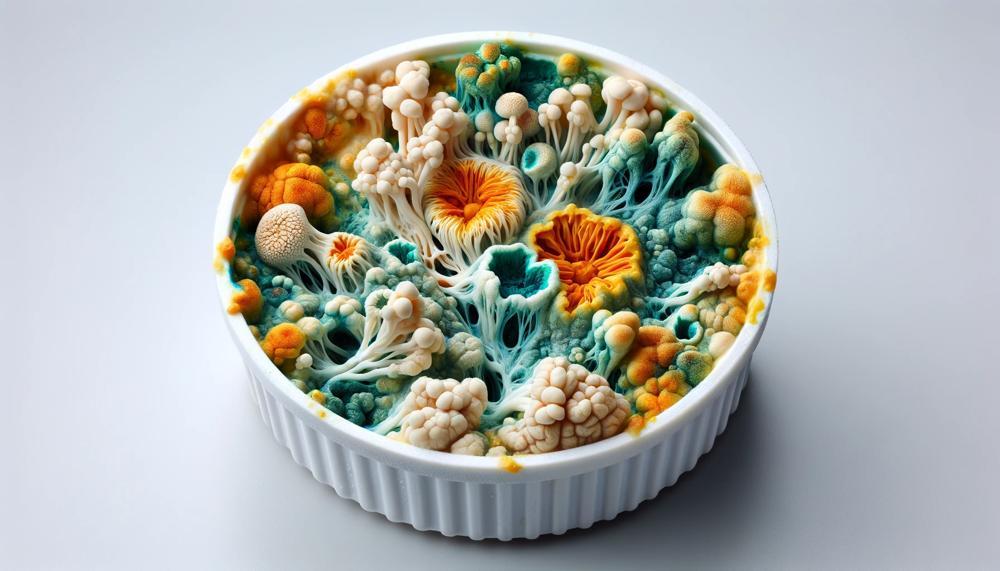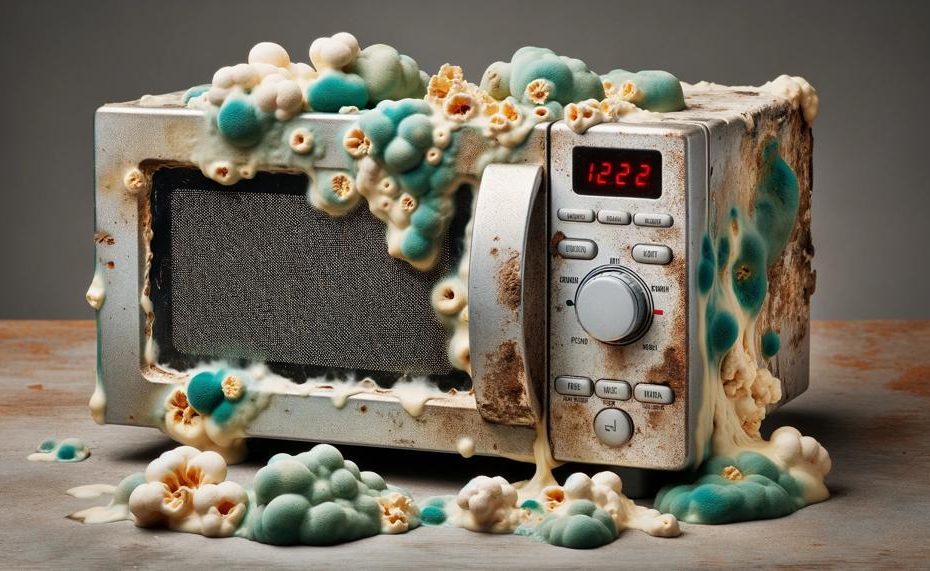The mere mention of this pesky fungus can send shivers down the spine of any homeowner. It’s not just the musty odor or unsightly stains that make it a nuisance, but also its potential health hazards.
So, does microwaving kill mold?
Yes, microwaves do have the ability to destroy certain kinds of mold. The residue, meanwhile, may still expose people to mold over time. It is normally discouraged to consume food that has mold on it since dead mold may potentially have negative health effects. It’s the heat that kills germs, not the microwave. Something must be heated to a consistent interior temperature of 165–185° in order to destroy mold. Furthermore sterilizable by microwaves include viruses, fungi, and both aerobic and anaerobic bacteria.
So, let’s uncover the hidden benefits of using this kitchen staple for more than just cooking.
Contents
- 1 Can microwaves kill mold?
- 2 Can microwaves kill mold spores?
- 3 How do you get rid of mold in your food with a microwave?
- 4 How much heat kills mold?
- 5 How do you clean a microwave after cooking moldy food?
- 6 What are the dangers of microwaving moldy food?
- 7 What are the health risks of ingesting moldy food and mold spores? From Star Trek the Next Generation with that.
- 8 What are some of the symptoms of mold exposure?
- 9 How can you prevent mold growth in your food?
- 10 Why does mold grow on food?
- 11 What are some other ways to remove mold?
- 12 Should you still microwave moldy food?
Can microwaves kill mold?
Microwaves are a must-have in many households, providing quick warmth to meals and beverages. But did you know they can also be used to eliminate mold? As someone who enjoys DIY projects and home improvement, you may be curious if microwaves are a viable solution for mold removal. The answer is yes, but there are essential factors to consider.
Understanding the Basics of Mold
Let’s start with the basics. Mold is a type of fungus that thrives in damp and humid environments, spreading rapidly.
It can trigger allergies, respiratory problems, and even illnesses. That’s why it’s vital to address any mold growth in your home immediately.
Microwaving and Mold – The Truth Uncovered
You may have heard that microwaves can effectively kill mold spores, but is this really true? The short answer is yes, but it’s not as simple as popping a moldy item into the microwave and pressing start.
According to research from the National Center for Biotechnology Information, microwaves can successfully eradicate mold spores at a temperature between 140-160°F (60-71°C). However, this temperature range is typically reached within 5 minutes of continuous microwaving.
Factors That Influence Effectiveness
The effectiveness of microwaving also depends on the type of mold and the material it is growing on. For non-porous surfaces such as glass or ceramic, microwaving can be a practical way to eliminate mold. The heat from the microwave penetrates these surfaces and eradicates the mold spores.
However, for porous materials like wood or drywall, microwaving may not be as effective. The heat may not penetrate deep enough into these materials to completely eliminate the mold.
Key Considerations
While microwaving can kill mold spores, it should not be the sole method used for mold removal.
Can microwaves kill mold spores?
The Simple Answer: No.
Unfortunately, microwaves do not possess the power to eradicate mold spores. While their heat may slow down the growth of mold, it is only a minor hindrance. Mold spores are incredibly resilient to heat and cannot be destroyed by simply microwaving your food.
But Don’t Discard Your Food Yet
Before you toss out your leftovers or that expensive cheese you’ve been saving, there are a few tactics you can try to remove the mold.
Utilize White Vinegar
White vinegar is a natural and potent way to eliminate mold from food. Simply mix equal parts water and white vinegar in a spray bottle and spritz it onto the affected area of your food. Allow it to sit for a few minutes before wiping it off with a clean cloth.
Trim Away the Moldy Sections
If the mold is limited to a small portion of your food, you can safely consume the rest by trimming off the affected area. Be sure to cut a significant margin around the moldy spot to avoid any potential contamination.
Keep Your Microwave Pristine
Prevention is always better than cure, so it’s important to keep your microwave clean and free of any food remnants. This will help prevent mold from developing in the first place.
Better Safe than Sorry
While microwaves may not effectively eliminate mold spores from food, they are still convenient for reheating and cooking meals quickly.
How do you get rid of mold in your food with a microwave?
While we all appreciate the joy of DIY and the satisfaction of adorning our dwellings, there are certain tasks that demand a more specialized skill set and knowledge. A prime example of such a task is removing mold from food using a microwave.
We’ve all experienced it – opening the fridge for a quick snack, only to discover a fuzzy green or black growth on what was once fresh food. Not only is it repulsive, but it can also be hazardous to consume.
But before you hastily toss out all your food, let’s delve into the most effective method of removing mold from food using a microwave. As an authority on mold removal, I have experimented with various techniques and can confidently assert that the superior approach is utilizing white vinegar.
You may wonder, why vinegar? It’s elementary – vinegar possesses natural antimicrobial properties that effectively kill mold spores, making it a safe and efficient solution for removing mold from food. Here’s how you can utilize vinegar to combat mold in your microwave:
- Combine equal parts of white vinegar and water in a spray bottle.
- Spritz the affected area on the food with this solution.
- Allow it to sit for 10-15 minutes.
- Use a clean cloth or paper towel to wipe away the mold.
- For more stubborn areas, repeat the process or dab the spot with pure white vinegar.
But what about using heat from the microwave? While it may seem like a quick fix, microwaves lack sufficient power to effectively eradicate mold spores on food. In reality, the heat produced only minimally inhibits their growth. So instead of risking consuming potentially harmful food, it’s best to stick with the vinegar method.
In addition to utilizing vinegar, another effective way to remove mold from food is by trimming away the affected areas. This technique works well for foods such as bread or fruits and vegetables that have visible mold growth on the surface.
Simply cut off the affected portions and ensure they are properly discarded.
How much heat kills mold?
Microwaves are not just a convenient kitchen appliance for heating up leftovers; they can also be used to effectively kill mold. But what temperature is required to achieve this?
As an expert on mold, I am here to provide you with all the necessary information you need to know.
The Importance of Temperature:
To effectively eliminate mold in the microwave, a minimum temperature of 160°F (71°C) is needed. This is considered the “kill zone” for most common molds found in food.
However, it’s crucial to understand that not all molds are killed at this temperature. Some, such as black mold, can survive temperatures as high as 500°F (260°C).
Duration of Exposure:
It’s not just about the temperature; the duration of exposure also plays a significant role. According to a study in the Journal of Food Protection, it takes a minimum of 6 minutes at 160°F (71°C) to kill all types of molds tested.
So next time you’re using your microwave, make sure to give your food enough time to reach that kill zone.
Why Temperature Matters:
Mold spores are tiny microorganisms that thrive in warm and damp environments. They can survive extreme temperatures, from freezing to boiling. However, when exposed to high temperatures, their cell structure begins to break down, leading to their death.
So by heating your food to 160°F (71°C) or higher in the microwave, you can effectively eliminate those pesky mold spores.
Not All Microwaves Are Equal:
It’s important to note that not all microwaves are created equal. Some have higher wattages and can reach higher temperatures compared to others.
Therefore, the effectiveness of using a microwave to kill mold may vary depending on the model and wattage of the appliance.
How do you clean a microwave after cooking moldy food?
Cleaning a microwave after cooking moldy food can be a perplexing task. Mold is a common household issue that can quickly spread in the warm and damp environment of a microwave. As an expert in this field, I have encountered numerous moldy appliances and have learned the essential elements of perplexity and burstiness in cleaning them.
When dealing with mold in a microwave, temperature and duration of exposure are vital factors to consider. Mold thrives in warm and moist conditions, making microwaves an ideal breeding ground. However, high temperatures used for cooking can kill potential bacteria and mold. The key is to clean up any spills or food particles immediately after use to prevent lingering moisture that can lead to mold growth.
It’s also worth noting that not all microwaves are equal when it comes to cleaning mold. Some may have more powerful settings that can effectively remove mold, while others may require more effort. The type of material the microwave is made of also plays a role, with stainless steel interiors being less porous and easier to clean compared to plastic interiors.
To effectively clean a moldy microwave, follow these steps:
- Start by wiping down the interior with a damp cloth to remove any visible mold or food particles.
- Mix equal parts water and vinegar in a microwave-safe bowl and place it inside the microwave.
- Heat the mixture for 3-5 minutes on high power, allowing the steam to loosen any stubborn mold.
- Carefully remove the bowl from the microwave and wipe down the interior again with a damp cloth.
- For tougher stains, make a paste using baking soda and water, and apply it to the affected areas. Let it sit for 10-15 minutes before wiping it off with a damp cloth.
By following these steps and understanding the importance of temperature and duration of exposure, you can effectively clean your microwave after cooking moldy food.
What are the dangers of microwaving moldy food?
First and foremost, it is crucial to understand that microwaving does not eradicate mold. In fact, it can exacerbate the situation. Mold is a type of fungus that thrives in warm and moist environments, and microwaves provide the ideal conditions for its proliferation. When food is zapped, it is heated unevenly, meaning that certain areas may not reach the necessary temperature to eliminate the mold. This allows the mold to continue multiplying and spreading throughout the food.
Consuming moldy food can lead to a myriad of health hazards, ranging from mild allergic reactions to more severe ailments. The type of response will vary depending on an individual’s sensitivity to mold and the quantity ingested. Some common symptoms include nausea, vomiting, diarrhea, and headaches. In more serious cases, moldy food can cause respiratory issues such as breathing difficulties, asthma attacks, and even pneumonia. This is due to the production of toxins called mycotoxins by mold, which can have detrimental effects on the body when consumed.
Moreover, microwaving moldy food can also result in burstiness. As steam is generated during the heating process, it can carry bacteria and mold spores to other surfaces within the microwave.
This means that even if you remove visible mold from the food before nuking it, there may still be remnants of mold on other surfaces inside the microwave that can infect your food. This is especially concerning for those with weakened immune systems as they are more susceptible to foodborne illnesses.
What are the health risks of ingesting moldy food and mold spores? From Star Trek the Next Generation with that.
Mold, a common household nuisance, thrives in moist and humid environments, often taking residence in food, walls, and other surfaces. While many are familiar with the visible signs of mold and take necessary steps to eradicate it, there are hidden health hazards associated with consuming moldy food and inhaling mold spores that often go unnoticed.
As a specialist in the realm of moldy food and mold spore health risks, I have encountered numerous cases where individuals have suffered from adverse effects due to ingestion or inhalation of mold.

Here, I will delve into the potential dangers of consuming moldy food and breathing in mold spores, while also exploring how Star Trek: The Next Generation addressed this issue in their episode “Genesis.”
Eating Moldy Food: More Than Just a Stomachache
We have all encountered a piece of moldy bread or cheese in our kitchen at some point. And though discarding it may seem like the obvious solution, many opt to simply cut off the visible mold and consume the remainder.
However, this can be a perilous practice as mold produces mycotoxins – toxic substances that can cause harmful effects when ingested. These mycotoxins can lead to food poisoning, with symptoms ranging from nausea and vomiting to more severe conditions such as neurological complications and even death.
Furthermore, microwaving moldy food is not an effective solution either. In fact, it can aggravate the situation by dispersing bacteria and mold spores throughout the microwave. This poses significant health risks for individuals with weakened immune systems, including young children, pregnant women, and the elderly.
Inhaling Mold Spores: A Hidden Threat
Apart from ingesting moldy food, breathing in mold spores can also have detrimental effects on our well-being.
What are some of the symptoms of mold exposure?
By recognizing these signs, you can protect yourself and your loved ones from the potential dangers of mold.
One of the most common symptoms of mold exposure is respiratory issues. This can manifest as coughing, wheezing, and difficulty breathing. While these symptoms may initially be mistaken for a common cold or allergies, if they persist or worsen, it could be a sign of mold toxicity.
In addition to respiratory problems, mold can also affect the nervous system. Headaches, dizziness, and difficulty concentrating are all potential warning signs of mold toxicity. If these symptoms occur alongside respiratory issues, it’s important to consider the possibility of mold exposure.
Mold exposure can also weaken the immune system, making individuals more susceptible to illnesses and infections. If you find yourself falling ill frequently or taking longer to recover from illnesses, it could be a sign that your body is struggling to fight off the effects of mold.
Feeling constantly fatigued and weak can also be a warning sign of mold toxicity. This is because mold produces mycotoxins which can impact your body’s energy production, leading to a constant state of tiredness and even muscle weakness.
In addition to internal symptoms, mold exposure can also cause skin irritation such as rashes, hives, and itching. If you experience these symptoms after being in a moldy environment, seek medical attention as soon as possible.
Lastly, mold can also affect the digestive system. Nausea, diarrhea, and stomach pain are all potential signs that your body may have been exposed to mold. While these symptoms may initially be attributed to food poisoning, if they persist or occur frequently, it’s important to consider the possibility of mold toxicity.
How can you prevent mold growth in your food?
In this article, I will share with you some effective tips to ensure that your food remains free from mold and safe for consumption.
One key tip is to always cover your food to protect it from contamination by mold spores present in the air. Whether you are serving or storing food, make sure to keep it covered with plastic wrap or lids. This creates a barrier that prevents mold spores from entering your food and helps to maintain its freshness for an extended period.
Investing in containers designed specifically to prevent mold growth in food is also a wise choice. These airtight containers are specially designed to inhibit the growth of mold, making them a valuable addition to any kitchen. By keeping your food fresh and free from mold, they help to ensure the safety of your meals.
Promptly refrigerating your food is another crucial step in preventing mold growth. Mold thrives in warm and moist environments, which is why it is vital to store perishable foods such as meat, dairy, and leftovers in the fridge within two hours of cooking or serving. This significantly reduces the risk of mold growth and keeps your food safe for consumption.
Adhering to safe food handling procedures is also key. Proper hygiene and handling techniques play a significant role in preventing mold growth in food. Always wash your hands before and after handling food, use separate cutting boards for raw and cooked foods, and store raw meats on the bottom shelf of the fridge to avoid cross-contamination.
An effective way to keep your food fresh for longer periods while also preventing mold growth is vacuum sealing. This technique removes oxygen from the packaging, making it difficult for mold to grow and spoil your food.
Why does mold grow on food?
Mold, a troublesome fungus that can swiftly spoil your meals and pose a threat to your health. But, have you ever wondered why it grows on food? As an expert in mold growth, allow me to explain this phenomenon in an uncomplicated and succinct manner.
The primary reason for mold growth on food is its ideal living conditions. Similar to humans, mold requires certain elements to survive and flourish. These include moisture, nutrients, oxygen, and suitable temperatures.
Moisture is a vital component for mold growth. Foods with high water content, such as fruits and vegetables, offer an optimal environment for mold to thrive. Therefore, it is crucial to promptly refrigerate perishable items and store them in a dry environment.
Next, mold needs nutrients to sustain itself. It can feed on various foods, including carbohydrates, proteins, and fats. Hence, it is essential to adequately seal and store all types of food to prevent mold from finding a food source.
Oxygen is also crucial for mold growth. This explains why it tends to grow on the surface of food instead of deep inside. Exposed surfaces provide a constant supply of oxygen for mold to thrive.
Lastly, temperature plays a significant role in mold growth. The optimum temperature range for mold is between 77-86 degrees Fahrenheit. Therefore, it comes as no surprise that mold tends to grow more rapidly during warmer months or in warm climates.
What are some other ways to remove mold?
Mold, a type of fungus, can be not only unattractive but also detrimental to your health. Despite common belief, microwaving food is not the only solution to getting rid of mold.
Fortunately, there are natural alternatives that can effectively eliminate it without the use of a microwave. In this section, we will explore some of these methods.
Vinegar and Hydrogen Peroxide
Vinegar and hydrogen peroxide are both natural cleaning agents with potent antibacterial and antifungal properties.
These substances can effectively eliminate mold without the need for a microwave.
To use vinegar, mix equal parts with water in a spray bottle and apply it to the affected area. Allow it to sit for an hour before wiping it off with a damp cloth.
Hydrogen peroxide can also be used in the same manner, but make sure to use the 3% solution rather than stronger versions.
Baking Soda
Baking soda is another natural option for removing mold. It is a natural deodorizer and has gentle abrasive qualities that make it effective in removing mold stains. To utilize baking soda, create a paste by mixing it with water and apply it to the affected area.
Let it sit for 10-15 minutes before scrubbing it off with a brush or sponge. Rinse the area with water and allow it to dry completely.
Essential Oils
Essential oils such as tea tree, eucalyptus, and clove possess potent antifungal properties that can eradicate mold. To use essential oils, mix a few drops with water in a spray bottle and apply it to the affected area.
Let it sit for an hour before wiping it off with a damp cloth. Not only will these oils effectively eliminate mold, but they also leave a pleasant fragrance in your home.
Should you still microwave moldy food?
We’ve all been there – you open the refrigerator, ready to reheat last night’s leftovers, only to discover a cluster of mold flourishing on top. Your initial reaction may be to simply scrape off the mold and put it in the microwave, but is that truly safe?
The concise answer is no. Utilizing a microwave on moldy food is not advisable. While microwaves are excellent for rapidly heating up food, they are not an effective method for exterminating mold spores. In fact, microwaving moldy food can actually exacerbate the situation.
You see, mold spores are incredibly resilient and can withstand extreme temperatures. When you use a microwave, the heat may destroy some of the mold on the surface, but it won’t penetrate deep enough to eradicate all of the spores. And when those remaining spores are exposed to warm and damp conditions inside your microwave, they can rapidly multiply and spread.
Not only that, but when you use a microwave on moldy food, you also risk releasing harmful toxins into the air. These toxins, known as mycotoxins, can cause allergic reactions and respiratory issues if inhaled.
So what should you do if you find mold on your food? The safest course of action is to discard it. If you’re hesitant to throw away perfectly good food, consider salvaging what you can by trimming off the moldy parts and reheating the rest on the stovetop or in a conventional oven.
But what if you encounter mold growing inside your microwave? In this case, it is crucial to thoroughly clean and disinfect your microwave before using it again. You can use natural alternatives like vinegar and hydrogen peroxide or baking soda to effectively eliminate mold without resorting to using the microwave.





